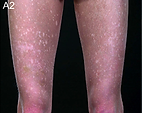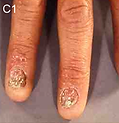WHAT IS DYSKERATOSIS CONGENITA?
Dyskeratosis Congenita (DC) is a severe bone marrow failure syndrome which is a genetic disorder that can affect many systems of the body. Different people will be affected in various ways and this is why DC is a complex condition.
Dyskeratosis Congenita affects the bone marrow which means it does not work properly. People with DC may have symptoms such as feeling tired, being less able to fight infection and the person’s blood might not clot properly (which means they might be at risk of bleeding which is serious or can be life threatening).
This is why in severe cases a bone marrow transplant may be necessary.
SYMPTOMS
People with Dyskeratosis Congenita may have symptoms of:
Abnormalities of the skin:
People with Dyskeratosis Congenita can have abnormalities of the skin (Pigmentation changes). Ask your Doctor to refer you to a Dermatologist if you have any worries about your skin).
Abnormalities of the nails:
People with Dyskeratosis Congenita can be affected with symptoms of nail ridges, destruction /loss of nails. Consult your Doctor if you have any of these nail problems and ask to be referred to a Dermatologist.
Leukoplakia:
People with Dyskeratosis Congenita can be affected by Leukoplakia, which are white patches on the tongue, cheek, gums, roof or floor of mouth or lower lip. It is important to have regular dental checks because the Dentist can identify some of these abnormalities. Visit your dentist if you have any concerns and ask for symptoms to be checked.
Abnormalities of the skin and nails usually occur before the age of 10 years (but these can be difficult to diagnose if not seen by a Specialist).
These photos have been kindly reproduced with permission from Professor Inderjeet Dokal.



Your Doctor can talk to you about the diagnostic criteria for Dyskeratosis Congenita.
Some people with Dyskeratosis Congenita may or may not also have other symptoms which might include:
-
Abnormalities of the eyes
-
Dental problems (poor dental health and loss of teeth)
-
Skeletal problems (muscular and bone pain)
-
Gastrointestinal/ bowel problems
-
Genitourinary problems (kidneys, bladder problems)
-
Respiratory problems (poor lung function & breathing difficulties)
-
Dysphagia (difficulty in swallowing and choking easily).
There can be an increase in malignancy (some cancers) affecting the skin and gastrointestinal systems.
There is also a high incidence (80%) of bone marrow problems leading to anaemia and increased risk of bleeding and infections.
WHEN DO SYMPTOMS FIRST OCCUR?
Symptoms usually occur during childhood. There can be changes in skin pigmentation and nails. These symptoms usually occur by the age of 10 years. The more serious complications of bone marrow failure (Aplastic anaemia) and malignancy usually develop in the second and third decades of life. This is why Dyskeratosis Congenita can be hard to diagnose. It is very helpful if you think of symptoms you have had to discuss these with your Doctor.
A Specialist opinion should be sought for diagnosis of Dyskeratosis Congenita and to help with an appropriate treatment plan. Patients who develop abnormalities in their bone marrow are at risk of life threatening infections and bleeding.
There are many drugs and medications used as part of the treatment plan. If bone marrow failure is severe bone marrow transplant may be considered. Stays in hospital may be necessary under a Haematologist or Specialist Consultants.
